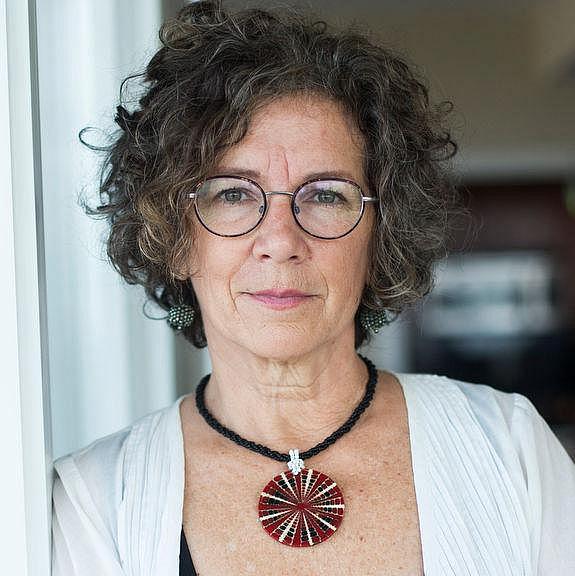COMMUNITY VOICES: Don’t let what happened to my children happen to yours
This story was produced as part of a larger project led by Amy Roost, a participant in the 2019 California Fellowship.
Other stories in this series include:
A Pesticide the EPA Won’t Ban Is Sickening Low-Income Californians of Color

Amy Roost.
In 1989, a fetus developed with a neural tube defect and a terminal malformation of the brain.
In 1992, a child born with his esophagus connected to his trachea instead of his stomach and a host of other birth defects is slow to reach developmental milestones and is eventually diagnosed with two brain malformations at age 15.
In 1993, a third child is born without complications or developmental delays, only to be diagnosed with an inoperable brain malformation at age 19.
Three children belonging to the same set of parents, with a combined total of four brain malformations that doctors say are unrelated. “The doctors are wrong,” says the mother, with the certainty born of maternal instinct.
It’s not until March 2017 when the mother hears a story on NPR about the Trump administration lifting a ban on the pesticide chlorpyrifos that she will have evidence on which to pin her hopes. It’s also what leads her to test a hypothesis that her children’s brain malformations are somehow related to each other and to chlorpyrifos.
The reason I know this tragic story is because the mother in question is me.
Now, I’m taking my quest for answers beyond the personal. I’m producing a podcast about the health risks of exposure to chlorpyrifos in agricultural communities. My goal is to meet anyone with a stake in this issue — residents, Agriculture Board commissioners, farmers, activists, doctors, scientists — to hopefully answer a pressing question: why is it that a pesticide that was deemed unsafe for household use some 20 years ago is still being sprayed near residences and schools in Kern County?
In order to answer this question, I’ll need the community’s help to get it right because the most successful interventions are those crafted with input from the people most affected.
I care deeply that what happened to my children doesn’t happen to the children of Kern County. That’s why over the next few months, my editor and I will be visiting Kern County to get to know the area and meet many of you. We’ll be asking about your work, your health, your children and the schools they attend. With your input, we hope our reporting will help you, your family and friends avoid encountering the risks that I encountered while pregnant.
You may be wondering, isn’t chlorpyrifos just a pesticide like any other? The answer is no, according to Nayamin Martinez, executive director of the Central California Environmental Justice Network (CCEJN).
“In Fresno County alone,” says Martinez, “there are six schools that have more than 500 pounds of chlorpyrifos applied in 2016, that would mean a 57 percent increase in the odds of having a child with autism.” Unfortunately, the list of long-term health effects of chlorpyrifos is not limited to autism. The list also includes low birth weight, attention deficit disorder, reduced IQ and structural changes in the brain, Parkinson’s Disease, heart disease, and asthma.
Recently, the California EPA said it plans to ban chlorpyrifos. However it could take up to two years for the ban to take effect. In the meantime, organizations such as the CCEJN, Californians for Pesticide Reform and and the Pesticide Action Network will continue to take action aimed at stricter rules on where and how the chemical can be applied.
And so should you. One way to do this is to participate in my reporting project. Another way is to get involved on a grassroots level volunteering with one of the organizations listed above. Residents may also wish to phone or email state representatives.
Finally, it is critical that people who live, work and study near the fields where chlorpyrifos is applied — who are at the greatest risk of exposure — take action in their own homes. For instance, if you work in farming, it’s vital to remove work shoes before entering the home so as not to track the pesticide onto the floors where small children crawl and play. Also, work clothes should always be washed separately from the rest of the family laundry to prevent cross contamination.
Together we can change the dialogue and habits around chlorpyrifos to focus on preventing exposure, and finding safe alternatives that will ease the transition for an agricultural industry that employs so many throughout the region.
If you would like to contribute to my reporting by talking about your experience with chlorpyrifos, please contact me at 858-735-8992 or email me at AMYeRoost@gmail.com. Para asistencia en español, por favor llame Amy Westervelt at (415) 341-6350.
Amy Roost is a 2019 Annenberg Center for Health Journalism Fellow and a documentary podcaster residing in San Diego. She can be reached at 858-735-8992 or AMYeRoost@gmail.com.
[This article was originally published by Bakersfield.com]

